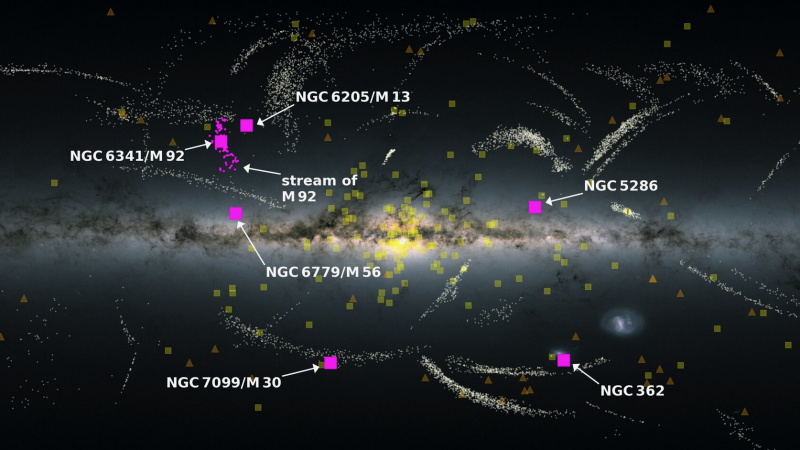
History of Milky Way mergers
Astrometry is the branch of astronomy that deals with precise measurements of star positions. Astronomers measure a star position, then measure it again. And again. And, over time, they get a sense of how stars are moving across our sky, and therefore in our Milky Way galaxy. Astrometry is painstaking work. But, in recent years, ESA’s mighty Gaia satellite has acquired astrometric measurements for more than a billion Milky Way stars. So – as they analyze Gaia’s data – astronomers are coming to know how Milky Way stars are moving over time.
That’s what this story is about. It’s about astronomers analyzing Gaia data to learn about star motions. And it’s about how that knowledge has enabled astronomers to deduce a history of star motions in our galaxy. Because, after all, if a star is moving on a particular path now, it’s likely been on that same path for millions or billions of years. Early this morning (February 17, 2022), astronomers announced a new insight obtained via Gaia. They said their new study has revealed a history of Milky Way mergers.
According to a statement from ESA:
In total they studied 170 globular clusters, 41 stellar streams and 46 satellites of the Milky Way. Plotting them according to their energy and momentum revealed that 25% of these objects fall into six distinct groups. Each group is a merger taking place with the Milky Way. There was also a possible seventh merger in the data.
Khyati Malhan of the Max Planck Institute for Astronomy in Heidelberg, Germany, led the new work. He and his team said their new work constitutes an “atlas” of mergers with our home galaxy, the Milky Way. His statement explained:
Where earlier studies had reconstructed such mergers ‘by hand,’ the new study applied a systematic statistical evaluation of 257 stellar streams, globular clusters and satellite galaxies …
These astronomers said of their study of stellar streams in the Milky Way that their new results are:
… An important step towards a more complete reconstruction of our galaxy’s billion-year history.
The peer-reviewed Astrophysical Journal published their results on February 17.
Past galaxy mergers with our Milky Way
Our Milky Way galaxy is known to have more than 50 satellite galaxies. That’s not a lot, given that popular modern theories of our universe call for dozens or more satellite galaxies orbiting every galaxy. Because everything in space is moving, and because the gravity of bigger bodies (like our Milky Way) is always tugging at smaller bodies (like satellite galaxies), some satellite galaxies will inevitably merge with our Milky Way over time. In fact, modern cosmological theory calls for galaxies to grow – both in mass and in size – through a sequence of mergers.
And indeed prior studies of our Milky Way have revealed evidence for five mergers, with five former dwarf galaxies. Astronomers call these five erstwhile Milky Way satellite galaxies by these names: Sagittarius, Cetus, Gaia-Sausage/Enceladus, LMS-1/Wukong and Arjuna/Sequoia/I’itoi.
This study revealed a sixth galaxy merger, with a dwarf galaxy these researchers call Pontus. In Greek mythology, Pontus is the name of one of the first children of the Greek goddess Gaia, who is the personification of the Earth. The astronomers said:
The small galaxy Pontus, merging with our own, moved in the direction opposite to the rotation of the Milky Way’s disk, at comparatively low energy, which might hint at a very early date for that particular merger.

Creating a merger atlas
The Gaia mission was launched in 2013. And since then it has been releasing its data in “data sets,” the first of which was released in 2016. Now there have been three Gaia data sets released (the next will be released in June 2022). These astronomers used an early version of Gaia’s Data Release 3 (EDR3), which was published on December 3, 2020. Like all the Gaia data sets, it contains what these astronomers called:
… notably exquisitely accurate locations [of stars] as well as information about the changes of their position in the sky (proper motion).
By the way, in case the term is unfamiliar to you, stellar streams are associations of stars that were torn apart and stretched out by tidal forces (the same sort of gravitational forces that create tides in Earth’s oceans) within the Milky Way. These astronomers said the Gaia mission was already responsible for doubling the number of known stellar streams from about 25 to about 50.
These astronomers also commented:
Stellar streams are not readily visible in the night sky; in fact, if you were to look at images of some regions of the sky containing a stellar stream, you would be hard-pressed to recognize the stellar stream as such. But Gaia’s data about the apparent movement of billions of stars in the sky … allows for the reconstruction of the motion of stars. And nearby stars moving in about the same direction are a telltale sign of stars that are part of one and the same stellar stream.
Next steps
These astronomers concluded:
What the present analysis does not yet permit is a reconstruction of the chain of events, of the order in which the different mergers occurred.
This is what the researchers now hope to reconstruct as a next step, by running simulations of how those mergers are likely to have taken place. If all goes well, the comparison between the simulations and the available data could allow for a reconstruction of how the stellar halo of our galaxy was built up over the past billions of years, one merger at a time.

Bottom line: Astronomers analyzed Gaia data to create an atlas of Milky Way mergers with smaller galaxies. They confirm five known past mergers and found evidence for a sixth, which they call Pontus.











